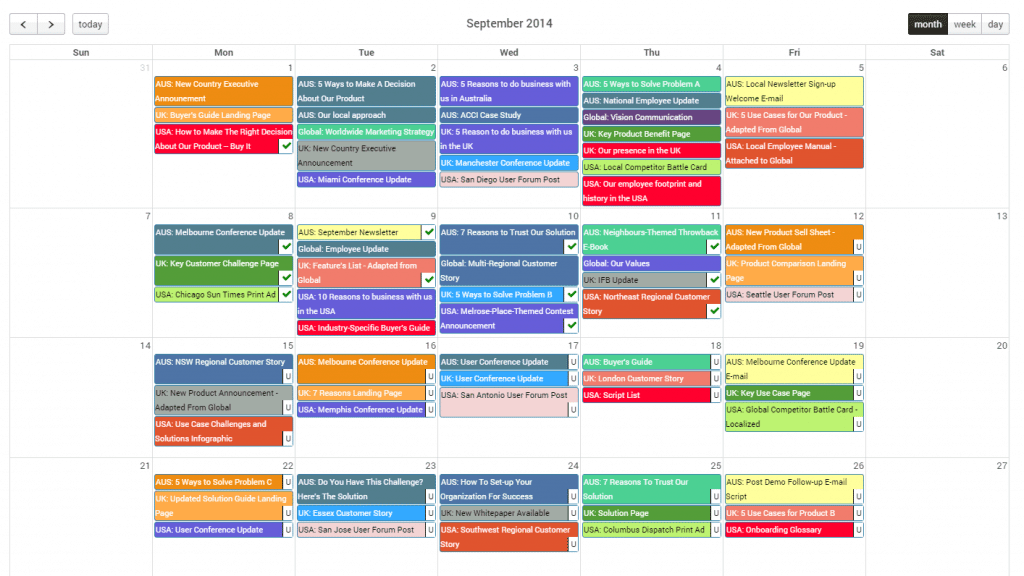In today’s digital world of online marketing, planning and organizing can sometimes be a bit hectic when it concerns your online content. Having it as organized as possible will not only keep you on track but will also enable you to track your online content and how to best produce it. When it comes to content calendars, you need to think more like a publisher.
Publishing your content is key in successfully accomplishing your content strategy. In order to do this, you must first learn to create a successful content calendar that will not only keep you on track but also better utilize your online marketing content. You can achieve this by using the following tips:
Familiarize Yourself With the Layout
Now that you are ready to organize your online content, you need to know the layout of your content calendar. There are many content calendars you can use, such as HubSpot and Google Calendar, which are easy to navigate and keep your content organized. You can also choose to create your own that is specific to your online marketing needs. Depending on what kind of online content you need managed, you may want to research more advanced content calendars for reference. It depends on what specifications you need for your content and the marketing strategy that you have for it.

Once you have familiarized yourself with your content calendar, it will be a lot easier for you to track your content. Many digital calendars have a lot of tools and features to help you stay organized. For example, HubSpot offers inbound marketing optimization, which includes the following:
- Optimize keyword content on blog posts
- Track visitors and user engagement
- Analyze social media feed
- E-mail marketing and lead nurturing
- View reports that measure the effectiveness of your marketing
By using services such as HubSpot, you are sure to maintain control over your online marketing content and how you can best organize and track it on all social media platforms.
Track Key Dates
One of our most successful blog posts of last year was The Genius of Star Wars VII’s Marketing Machine. The post was published on December 15th, three days prior to the release date of that film and at the height of Star Wars mania. Because of this, we were able to reach a larger audience organically than if we had unveiled the blog in the months before or after. Structuring your content release schedule in advance can streamline efficiency and help you stay within your marketing budget by optimizing for organic traffic without resorting to ad spend.
When using a content calendar, it is important to not lose track of important key dates. The main purpose of a content calendar is to keep track of your content. When tracking your key dates, it is also important to itemize due dates and dates of importance. You wouldn’t want an event to sneak up on you and disrupt the flow of your content calendar.
By having a track of your key events, you can also document many of the recurring events that you can later adapt into future content calendars. These key dates may be in similar in nature to the following;
- Publishing Dates
- Production Deadlines
- Promotion Dates
- Review Dates
These types of key dates are not limited to the content within your calendar, how you organize your key dates depends solely on your content and what your goals are in content marketing.
Fill in Gaps
Gaps within a content calendar should always be taken advantage of. When creating your calendar, consider what you can do about the gaps surrounding existing events. You could use these gaps as opportunities to
- Feature guest bloggers
- Add impromptu events
- Extend existing events
The benefit of having a content calendar is for you to see from a bird’s eye view how your content is being managed. Without having a way to visually see the way in which your content is planned, it’s easy to become disorganized and potentially alter scheduled events, which can be debilitating to your business and cause problems later on.
Stick to the Plan
Often times, content calendars will not be maintained and become a disarrayed mess that becomes hard to repair. When you make a calendar, stick with it. Those deadlines were created for a reason and although it’s easy to forget and miss deadlines or become overwhelmed with competing priorities, the domino effect can disrupt your entire schedule.
Do not let the hustle and bustle of your business negate the responsibilities of tracking your content calendar. If not, you may become tempted to over-compensate by releasing too much content at once. This is a bad idea, especially with video content, and can may cause followers and potential leads to unsubscribe from your content platforms (i.e. subscriber burn).
Conclusion
Having a content calendar is necessary to maintaining your inbound marketing. You can either choose to use a free templet online or go rogue and create your own. Every content calendar is varying based on the content it surrounds. No matter your preference, you can create a great content calendar by keeping the following in mind:
- Learn the layout of your content calendar
- Track Key Dates
- Fill in Gaps
- Stick To It
Do you have any personal suggestions about creating a great content calendar? Leave a comment below!









